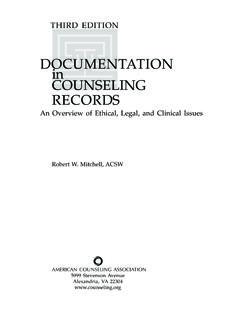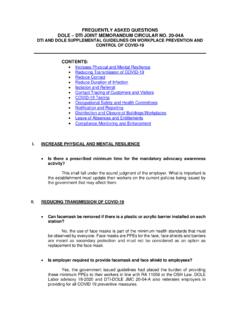Transcription of Military Construction: Authorities, Process, and ...
1 Military construction : process , Outcomes, and frequently asked Questions Lynn M. Williams Specialist in Defense Readiness and Infrastructure May 16, 2018. Congressional Research Service 7-5700. R44710. Military construction : process , Outcomes, and frequently asked Questions Summary Congress appropriates several billion dollars annually to support and sustain a broad footprint of Military bases, reflecting both a federal investment in local communities and a local investment in national defense. Specific Military construction project authorizations provided through the annual National Defense Authorization Act enable the Secretary of Defense and the Secretaries of the Army, Air Force, and Navy to plan, program, design, and build the runways, piers, warehouses, barracks, schools, hospitals, child development centers, and other facilities needed to support Military forces at home and overseas. This report describes and explains the end-to- end Military construction process by which DOD and Congress act together to build that footprint, beginning with the requirement for a facility and ending with the opening of its doors for occupancy.
2 The process encompasses several steps: determination of need by the local installation commander and engineering office, vetting and prioritization of construction projects within the Military chain of command and the Military department, consolidation and budgeting within the Office of the Secretary of Defense to create the infrastructure construction portion of the Future Years Defense Program (FYDP), inclusion of the final budget year list of projects in the annual President's Budget Request to Congress, review and adjustment of the list by the congressional defense committees , consideration and passage of the necessary authorization and appropriation bills and their enactment by the President, and execution of the approved construction program by the Military services'. executive agents Naval Facilities Engineering Command (NAVFAC) and Army Corps of Engineers (ACE). Congressional Research Service Military construction : process , Outcomes, and frequently asked Questions Contents Introduction.
3 1. The Legal and Budgetary Framework .. 1. Requirement for Project Authorization .. 1. Activities Funded Through Military construction Appropriations .. 2. Selected MILCON authorities .. 3. Planning, Programming, and Budgeting .. 5. Vetting and Prioritization Within the Military Services .. 7. Department of the Army .. 7. Department of the Air Force .. 9. Department of the Navy .. 9. National Guard .. 10. Appropriations, Authorizations, and Execution: From Paper to Bricks and Mortar .. 12. Solicitation of Bids .. 12. From Contract Award to Completion .. 13. Figures Figure 1. Military construction process .. 8. Figure 2. Legislative process / Congressional Operations .. 12. Figure C-1. Fort McNair Physical Fitness Center DD Form 1391 .. 22. Figure C-2. Fort McNair Physical Fitness Center DD Form 1391 .. 23. Tables Table B-1. Summary of Selected Military construction and Repair authorities .. 18. Appendixes Appendix A. frequently asked Questions (FAQs).. 15. Appendix B. Selected Statutes Governing Military construction and Repair authorities .
4 18. Appendix C. Case Study: Joint Base Myer Henderson Hall, Fort McNair Physical Fitness Center, DD 21. Contacts Author Contact Information .. 24. Congressional Research Service Military construction : process , Outcomes, and frequently asked Questions Introduction The Military missions of Department of Defense (DOD) units and organizations drive the need for facilities and the supporting infrastructure on any given Military installation. Therefore, as the missions assigned to those organizations change, as organizations move to or away from an installation, or as buildings age or become obsolete, facilities and supporting infrastructure may need to be replaced or reconfigured. While each of the Military departments has its own unique processes for vetting and setting Military construction (MILCON) priorities, the MILCON process is formally structured to comply with the Planning, Programming, Budgeting and Execution (PPBE) process of the Moving from the realization of need (requirements determination) through the planning, programming, and budgeting process could take three or more years for a MILCON project.
5 When adding the time required for congressional authorization and appropriations, implementation of the federal contracting process , and the physical construction of the project, the end-to-end Military construction process beginning with the realization of the need for a facility to the opening of its doors for occupancy may span seven years or more. The Legal and Budgetary Framework Chapter 169 of Title 10, United States Code, contains most of the laws governing Military construction matters. Section 2801 provides definitions of certain terms used in the chapter and elsewhere in law. It defines the term Military construction as any construction , development, conversion, or extension of any kind carried out with respect to a Military installation, whether to satisfy temporary or permanent requirements, or any acquisition of land or construction of a defense access road. 2 It also specifies that a Military construction project includes all Military construction work .. necessary to produce a complete and usable facility or a complete and usable improvement to an existing facility (or to produce such portion of a complete and usable facility or improvement as is specifically authorized by law).
6 Requirement for Project Authorization Section 2802 specifies that the Secretary of Defense and the Secretaries of the Military departments may carry out such Military construction projects, land acquisitions, and defense access road projects as are authorized by law. 3 It covers the following activities: surveys and site preparation;. acquisition, conversion, rehabilitation, and installation of facilities;. acquisition and installation of equipment and appurtenances integral to the project;. acquisition and installation of supporting facilities (including utilities) and appurtenances incident to the project; and planning, supervision, administration, and overhead incident to the project. 1. See CRS In Focus IF10429, Defense Primer: Planning, Programming, Budgeting and Execution process (PPBE), by Lynn M. Williams. 2. 10 2801. 3. 10 2821 holds a similar requirement for the construction and acquisition of Military family housing. Congressional Research Service 1. Military construction : process , Outcomes, and frequently asked Questions The MILCON-unique requirements specified in 10 2802 are in addition to 10 Section 114, which states that, for specified DOD programs including Military construction , no funds may be appropriated for any fiscal year.
7 Unless funds therefor have been specifically authorized in law In the practical application of these statutes, Congress has required project-by- project authorization and appropriation for Military construction Activities Funded Through Military construction Appropriations The annual Military construction , Veterans Affairs, and Related Agencies appropriation bill provides funding for DOD construction activities. Often referred to as the MILCON/VA. appropriations bill, the legislation appropriates project-specific amounts for major MILCON. projects, and also funds a variety of construction and construction -related activities, including the following: Unspecified Minor construction . construction projects estimated to cost no more than $6 million under authority provided in 10 2805. Unlike major MILCON projects, unspecified minor construction projects are not subject to specific congressional authorization; therefore, the amounts are appropriated as unspecified minor construction .
8 Planning and Design. Congress requires planning and design work on projected construction projects to be far enough along to provide confidence in the accuracy of the projected budget request. Accordingly, most of the construction projects included in the President's annual budget request are based on planning and design work that was funded by this nonspecific Family Housing New construction . Replacement, acquisition, expansion, addition, extension, and alteration of government-owned Military family Family Housing Operation and Maintenance. Debt payment, leasing, minor construction , principal and interest charges, and insurance premiums, as well as the provision of routine maintenance, utilities, and management of government- owned housing for families of servicemembers. DOD Housing Funds. Appropriations for the Family Housing Improvement Fund and the Military Unaccompanied Housing Improvement Fund to assure direct and guaranteed loans, utilize limited partnerships, and suggest DOD- owned property to encourage the private sector to increase available, affordable, and quality housing for Military Base Realignment and Closure (BRAC).
9 Functions associated with the implementation of BRAC 4. For more information on authorizations and appropriations see Government Accountability Office, Principals of Federal Appropriations Law, Fourth Edition, 2016 Rev., GAO-16-464SP, March 10, 2016, p. 2-54, 5. 10 2807. 6. While government-owned housing for servicemembers not residing with families (often referred to as barracks, dormitories, or bachelor officer quarters) is funded as major construction , Military family housing funds are separated under the general category of Family Housing.. 7. Treasury funds established under 10 2883. 8. Congress is still providing funding for implementation of FY2005 BRAC decisions. FY2018 appropriations totaled $310 million. For more information on BRAC implementation see Government Accountability Office (GAO), Key ( ). Congressional Research Service 2. Military construction : process , Outcomes, and frequently asked Questions North Atlantic Treaty Organization (NATO) Security Investment Program.
10 Contributions to the acquisition and construction of Military facilities and installations and for related expenses for the collective defense of the North Atlantic Treaty Chemical Demilitarization construction . Military construction necessary to support the destruction of the stockpile of lethal chemical agents and Selected MILCON authorities In addition to containing the statutes that define and underpin the congressional process related to MILCON activities, Chapter 169 of Title 10 establishes several monetary thresholds that set the framework for the MILCON budget process and the congressional oversight of facilities-related activities of the DOD. In prescribing the various authorities and responsibilities, Chapter 169 often uses the term Secretary concerned, referring to the Secretaries of the Military departments, or the Secretary of Defense in the case of a defense agency. In the case of MILCON thresholds, authorities , and limitations, it is important to note whether the authority applies to the Secretary of Defense or to each Secretary concerned individually.













